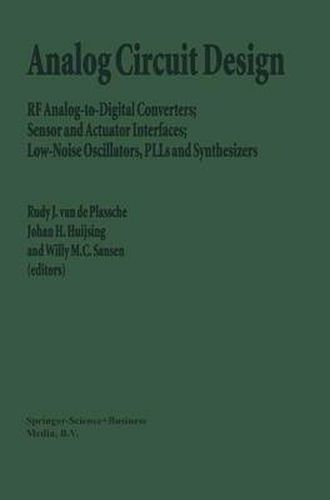Analog Circuit Design: RF Analog-to-Digital Converters; Sensor and Actuator Interfaces; Low-Noise Oscillators, PLLs and Synthesizers

Analog Circuit Design: RF Analog-to-Digital Converters; Sensor and Actuator Interfaces; Low-Noise Oscillators, PLLs and Synthesizers
This title is printed to order. This book may have been self-published. If so, we cannot guarantee the quality of the content. In the main most books will have gone through the editing process however some may not. We therefore suggest that you be aware of this before ordering this book. If in doubt check either the author or publisher’s details as we are unable to accept any returns unless they are faulty. Please contact us if you have any questions.
This volume of Analog Circuit Design concentrates on three topics: RF Analog-to-Digital Converters; Sensor and Actuator Interfaces; Low-Noise Oscillators, PLLs and Synthesizers. The book comprises six papers on each topic written by internationally recognised experts. These papers are tutorial in nature and together make a substantial contribution to improving the design of analog circuits. The book is divided into three parts: Part I, RF Analog-to-Digital Converters, the application of digital techniques to process analog modulated rf signals in radio receivers requires high linearity and high-resolution analog-to-digital converters. In portable applications these converters must have an extremely low-power consumption to allow a long standby time. In low-cost signal processing applications these converters are combined with a digital signal processing system onto a single chip. Today digital signal processing systems use advanced CMOS technologies requiring the analog-to-digital converter to be implemented in the same (digital) technology. Such an implementation requires special circuit techniques. Furthermore the susceptibility of converters to ground bounce or digital noise is an important design criterion. In this part different converters and conversion techniques are described that are optimized for receiver applications. Part II, Sensor and Actuator Interfaces, interfaces for sensors and actuators shape the gates through which information is acquired from the real world into digital information systems, and vice versa. The interfaces should include analog signal conditioning, analog-to-digital conversion, digital bus interfaces and data-acquisition networks. To simplify the use of data-acquisition systems additional features should be incorporated, like self-test, and calibration. To make these goals economically feasible, these functions should be integrated, preferably with the sensor, on a single chip. This part describes the latest techniques in sensor and actuator interface design. Part III, Low-Noise Oscillators, PLLs and Synthesizers, the phase noise of the receiver’s local oscillator limits the immunity against interfering signals. Therefore it has become the most important specification of the local oscillators of all integrated transceivers. Frequency synthesizers for digital tuning in portable radios require extremely low phase noise for the same reason. This part describes designs and architectures which give rise to very low phase noise. Analog Circuit Design is an essential reference source for analog design engineers and researchers wishing to keep abreast with the latest developments in the field. The tutorial nature of the contributions also makes it suitable for use in an advanced course.
This item is not currently in-stock. It can be ordered online and is expected to ship in 7-14 days
Our stock data is updated periodically, and availability may change throughout the day for in-demand items. Please call the relevant shop for the most current stock information. Prices are subject to change without notice.
Sign in or become a Readings Member to add this title to a wishlist.


